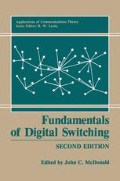Abstract
The previous chapters have addressed general topics related to digital switching, such as general switching networks and their controls, switching definitions, traffic theory, and switching system control and software. Many of these concepts are independent of whether the switch is analog or digital, space or time, or circuit- or packed-oriented. As the topics were discussed, areas of uniqueness were highlighted for the various types of networks. This chapter introduces the concept of time division circuit-switching networks and indicates how a circuit-switching function is performed in a time division system. The time division circuit-switching function is illustrated first for analog time division systems and then for digital time division systems, which forms the basics for digital switching. The digital time division networks then become the basis for the digital-switching systems discussed in Chapter 9. The remainder of this chapter describes the techniques and components associated with the networks characterized as time division circuit switches, as distinct from the packet switches described in Chapter 6. This chapter concludes with a discussion of potential future technologies for time division circuit switches, including sub-and super-rate, and optical switching. Later chapters will discuss the analog and digital terminations for the switch fabric, the impact of ISDN on the network, and some of the switching system architectures developed for public and private switching systems.
Access this chapter
Tax calculation will be finalised at checkout
Purchases are for personal use only
Preview
Unable to display preview. Download preview PDF.
References
S. Haykim, Communication Systems,Wiley, New York, 1978. Pages 430–435 contain a derivation of the sampling theorem.
T. E. Browne, D. J. Wadsworth, and R. K. York, “New Time Division Switch Units for No. 101 ESS,” Bell Syst. Tech. J, vol. 48, pp. 443–476, 1969.
K. W. Cattermole, “Efficiency and Reciprocity in Pulse-Amplitude Modulation: Part 1, Principles,” Proc. IEEE, England, vol. 105, pp. 449–462, 1958.
M. R. Aaron, “PCM Transmission in the Exchange Plant,” Bell Syst. Tech. J, vol. 41, pp. 99–141, 1962.
B. Benowitz, S. J. Butterfield, M. P. Chichetti, Jr., and T. G. Cross, “Digital Multiplexer,” Bell Syst. Tech. J, vol. 54, pp. 893–918, 1975.
A. W. Kobylar, “Method for Isolating a Set of Near Optimum PCM Digital Network Configurations,” Int. Conf. Commun (August, 1974), Paper 3YE. Also see a companion paper by S. G. Pitroda, Paper 3YD, in the same conference.
J. H. Huttenhoff, J. Janik, Jr., G. D. Johnson, W. R. Schleicher, M. F. Slana, and F. H. Tendick, Jr., “Peripheral System,” Bell Syst. Tech. J., vol. 56, pp. 1029–1056, 1977.
Integrating Packet Switching Technology into Digital Switching,“ Seminar DSW-10, Proc. Nat. Comm. Forum,pp. 1087–1092, 1987.
C. J. Weinstein and J. W. Forgue, “Experience with Speech Communication in Packet Networks,” IEEE Selected Areas in Commun., vol. SAC-1, pp. 963–980, 1983.
A. Hills and K. S. Scott, “Perceived Degradation Effects in Packet Speech Systems,” IEEE Trans. Acoustics, Speech, Signal Proc, vol. ASSP-35(5), pp. 699–701, 1987.
Various authors, Special Issue of Bell System Tech. J. on the digital data system, vol. 41, 1962.
J. P. Condreuse and M. Servel, “PRECLUDE: An Asynchronous Time-Division Switching Network,” ICC ’87,Seattle.
R. A. Spanke, “Photonics: Optical Switching,” Proc. Nat. Comm. Forum,pp. 10811086, 1987.
R. A. Spanke, “Architectures for Large Nonblocking Optical Space Switches,” IEEE J. Quantum Electron, vol. 0E-22, p. 969, June 1986.
Shedding Light on Optical Computing and Switching in Telecommunications,“ Seminar TEC-04, Proc. Nat. Comm. Forum,pp. 1279–1296, 1987.
P. W. Smith, “On the Role of Photonic Switching in Future Communications Systems,” Proc. 1987Int. Comm. Conf, IEEE Press, 1987.
Author information
Authors and Affiliations
Editor information
Editors and Affiliations
Rights and permissions
Copyright information
© 1990 Springer Science+Business Media New York
About this chapter
Cite this chapter
Slana, M.F. (1990). Time Division Circuit Switching. In: McDonald, J.C. (eds) Fundamentals of Digital Switching. Applications of Communications Theory. Springer, Boston, MA. https://doi.org/10.1007/978-1-4684-9880-6_5
Download citation
DOI: https://doi.org/10.1007/978-1-4684-9880-6_5
Publisher Name: Springer, Boston, MA
Print ISBN: 978-1-4684-9882-0
Online ISBN: 978-1-4684-9880-6
eBook Packages: Springer Book Archive

